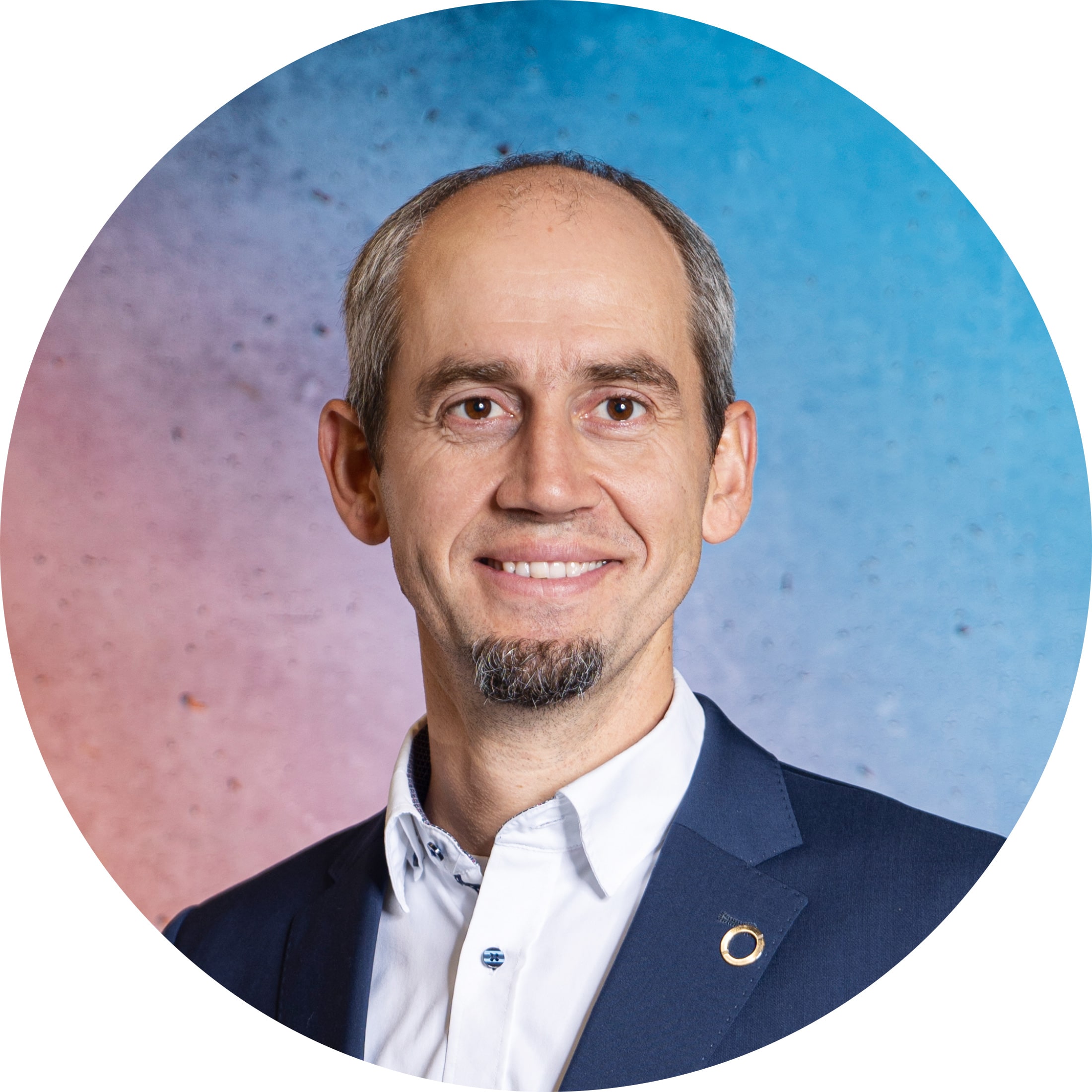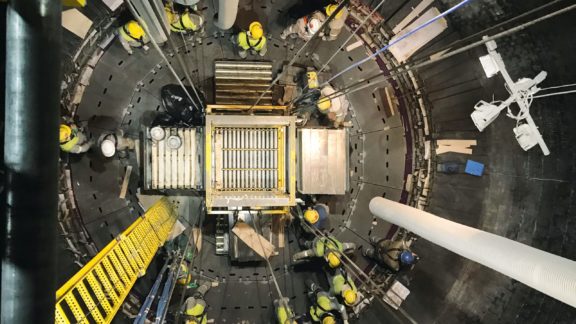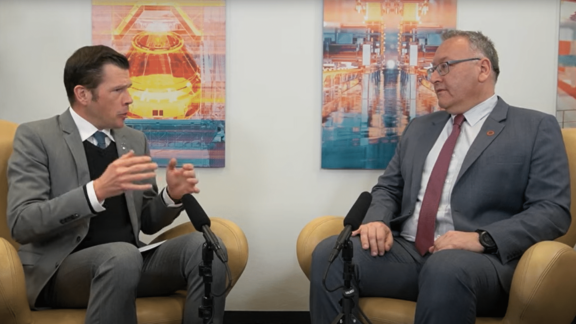Steel production is set to become more environmentally compatible than ever before. In this session of Pioneers Talk, Gerald Wimmer and Tom Widter discuss how to “green” the integrated production route, which relies on two of the main emitters of CO2 in the process chain—the blast furnace and the basic oxygen furnace. Other topics include the trend toward electric steelmaking, the increasing relevance of direct-reduced iron, and new solutions in the field of carbon capture and storage.
Pioneers Talk is the new video format of Primetals Technologies, focusing on informative and empowering interviews with experts in metals production and beyond. Topics extend to new advances in digitalization and automation, breakthroughs in green-production solutions, and success strategies for steel producers on all continents.

Interview with
Dr. Gerald Wimmer
Hello and welcome to Pioneers Talk. In today’s session we deepen our conversation on green production technologies in the steel industry. My name is Tom Widter and today I’ve invited Gerald Wimmer. Gerald is one of our experts in converter steel making, that is steel making using the basic oxygen furnace. I’ve heard that steel producers who rely on the integrated production route, that means blast furnace basic oxygen furnace, are facing some challenges maybe not today but in the near future and these challenges have to do with what to do to optimize their plants for carbon emissions. So, my first question to you, Gerald, is what can these producers do and are these challenges mentioned when you talk with producers?
Dr. Wimmer: Definitely, these are the topics that steel producers have to deal with today to solve these topics then in the near future. But for the start let’s have a look at the steel production today. Steel producers are making excellent business at the moment, so production is very high, earnings are very high, and I think this is very good for an industry that suffered a lot in the last years to recover and also to prepare for these challenges ahead.
So, the problem they have right now is they have to figure out what to do with the money they’re earning and the problem they may have in the near future is to plan for what’s to come and how to prepare for that scenario?
Dr. Wimmer: Yes, I think that’s a good summary.
That’s probably the immediate future and the short-term future. But if you look to the long-term future, are there certain technologies that you would recommend that these producers look into to ensure that their operations will remain profitable?
Dr. Wimmer: Definitely. There are a lot of ideas and solutions on the table and it already starts that we see that some of them are more promising than the other ones.
What’s the most promising one in your opinion?
Dr. Wimmer: At the moment it seems like green hydrogen-based direct reduction is the most promising solution to replace the blast furnaces which are the major emitters in the iron and steel industry with almost CO2 free production methodologies
So, that will be available next year the year after next?
Dr. Wimmer: The nice thing about the direct reduction, I mean there are different technologies which already exist but today they are using natural gas, natural gas is already a big share of hydrogen. That’s why today these plants emit less CO2 per ton of iron produced than the blast furnace and this technology is then adapted for hydrogen in a later step. Of course, these are changes where there is some development necessary, but this is not the big step because the plants would be ready at the moment, but we have to say that the hydrogen is not yet there at the right amount and at the right price.
That’s probably not a next year thing then?
Dr. Wimmer: Most likely.
Okay, we’ll see. We’re hopeful. If you look to the future, which you often do, and let’s say 20 years from now do you think that looking at the steel industry worldwide there will still be a split between developed nations and developing nations? Do you think that these countries will take different roles concerning metals production?
Dr. Wimmer: That’s a very difficult question. It’s very difficult to predict due to the one fact that the developed countries have a very big infrastructure with steel plants already installed. They already have huge capacities and it’s not very likely that they will expand a lot. In the developed countries the question will be how to transform the existing plants into the new world, into the greener world, while the developing countries where new capacities are required build new plants and of course for them it might be easier to directly use these new technologies. Developed countries with existing plants might focus more on solutions that allows to modify, optimize, or transfer the existing plants to come to a CO2 reduced steel production.
Do you have any examples for a technology that the developed nations in that scenario would rely on? Or an example for the developing nations as well?
Dr. Wimmer: Coming back to the topic of already existing capacities and existing plants, these plants are producing now, they make emissions now. We know that for the climate topic the cumulative CO2 emissions are important so the longer we make high emissions there harder we have to stop later. That’s why for the existing plants it’s very important to start with optimization. This will not bring us where we have to be, but this will be a very first and fast step to start with CO2 reduction. As for the existing plants and the recommendations, we have to look how far you can optimize your existing production to gain some time that you will need to implement new technology. For the developing countries where new capacities are installed it’s not recommended anymore to install classical coke plants, sinter plants, blast furnaces where we already know that this is not the future technology. Here we definitely have to look which technologies can be implemented instead.
Do you think that carbon capture and storage or direct reduction will play a major part in the future of steel making?
Dr. Wimmer: That’s a good question. At the moment, if we look at our customers and of course we have our opinion as a solution provider, but it’s also good to know what our customers are looking for and we look at all these strategies that the different steel producers are now communicating because they would like to show that they are committed to improve. We see that much more of them are betting on green hydrogen and direct reduction than on the carbon capture usage and storage. On the other hand, we see that our mother company Mitsubishi is very successful with these technologies in other areas and in other industries like the petrochemical industry. Maybe the carbon capture usage and storage technologies need more development and this might take place in other industries but then it might easily come back to the steel industry and take a larger share there.
I think that’s an interesting outlook and speaking of outlook and you’ve touched a little bit upon industries other than the metals industry. Is there any green technology that you find extremely fascinating that’s not immediately connected to the metals industry?
Dr. Wimmer: The one I have in mind is connected to the metals industry, but I think that’s also the reason why it’s interesting. If we look at a lot of these ideas like electrical cars, like changing our home heating to heat pumps, all these ideas rely on the principle that we reduce the CO2 emissions by using green electricity instead of the carbon we are using today. It all comes back at the very end to the question if we have this green electricity available? It’s very important regarding the timeline how fast this transition will come. I think this will be driven mainly by the question how fast we can get this green energy and therefore this is very interesting. Also, the latest discussion about nuclear power which some countries are trying to push will be very interesting to follow and see its outcome.
I think it’s very intriguing subject matter and I’m sure we’ll have more of these talks until hydrogen and green energy is really on stream to the extent that we needed but today this concludes this session of Pioneers Talk. Thanks very much for sticking with us and we’ll be back with another episode very shortly.
Dr. Wimmer: Thank you.
Dr. Gerald Wimmer
Dr. Gerald Wimmer knows all there is to know about converter steelmaking. Since joining Primetals Technologies in 2009, his R&D initiatives have resulted in many innovative solutions such as the Vaicon Link converter-suspension system and the Vaicon AOD Damper. Gerald holds a PhD with the University of Technology of Vienna and a master’s degree in international economics, enabling him to take the entrepreneurial view of a steel producer in addition to understanding the technology at work in a plant.
Dr. Tom Widter
Tom Widter joined Primetals Technologies in 2016 and now works in the Marketing and Communications department. He is Editor-in-Chief of Metals Magazine, the company’s customer magazine, and co-host of “Pioneers Talk”. Tom cares deeply about didactics, style, branding, the future of metals, personal growth, and the Oxford comma.


